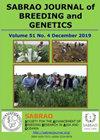哈萨克斯坦中部铀矿场各种植物群落的生产力评估
IF 1.7
Q3 PLANT SCIENCES
引用次数: 2
摘要
检查垃圾场、技术土壤和含有铀矿废物的地区的过度生长对于理解技术景观中植被覆盖的动态特征至关重要。以哈萨克斯坦山托别铀矿为例,研究了不同环境条件下堆积场和技术区内植物种类组成及其生产力的变化,以及土壤电离辐射强度的变化。垃圾场和技术基地的植被处于同生的早期阶段,是先驱者和群灌丛群落的代表。与强烈的硫酸盐盐碱化形成有关的不利生态条件在技术场所茁壮成长。然而,植物区系组成以高抗性种(Calamagrostis epigejos和Phragmites australis)和次生种为主。典型的哈萨克斯坦草原带植物群落的形成不会发生在这些地点。原铀矿复垦后的排土场和河岸的生产力相当高,为120-150克/平方米,与哈萨克斯坦北部的草甸-农村社区相匹配。而含铀矿石的非复耕和部分处理硫酸堆浸堆的生产率最低,为30 ~ 37 g/m2,这对作物植株的建立创造了极为不利的条件。在硫酸堆浸铀矿石部分处理过的堆堆中,几种自播植物具有足够的抗性,可以在高含硫酸盐水平和1200 ~ 1400 μR/hr电离辐射的土壤中生存。这些事实可以证明考虑在含铀堆积场人工草坪上种植这些植物以制造牧草的可能性。本文章由计算机程序翻译,如有差异,请以英文原文为准。
PRODUCTIVITY ASSESSMENT OF VARIOUS PLANT COMMUNITIES AT URANIUM MINE SITES IN CENTRAL KAZAKHSTAN
Examining the overgrowth of dumps, techno-soils, and areas containing waste products of uranium mines is vital for understanding the dynamic features of vegetation cover in technogenic landscapes. The main aim of this study was to investigate variations in the plant species composition and their productivity in dumps and technological areas and the intensity of soil ionizing radiations under varying environmental conditions based on the Shantobe Uranium Deposit, Kazakhstan. The vegetation at the waste dumps and technogenic sites is in the early stages of syngenesis and is representative of pioneer and group-thicket communities. Adverse ecological conditions associated with intense sulfate salinization formation thrive at the technological sites. However, the floristic composition is illustrative of highly resistant species (Calamagrostis epigejos and Phragmites australis) and secondary species. Typically the formation of steppe zone plant communities of Kazakhstan does not occur in these sites. The productivity of the recultivated dump and banks of the former uranium mine is quite high at 120–150 g/m2, which matches the meadow-ruderal communities of Northern Kazakhstan. However, the lowest productivity of 30–37 g/m2 emerged in the non-recultivated and partially processed sulfuric acid heap leaching stacks containing uranium ore, which create exceedingly unfavorable conditions for the establishment of crop plants. Several plant species identified as self-seeding live in partially processed piles of sulfuric acid heap-leaching uranium ores with a sufficient level of resistance to survive in soil with high levels of sulfate-containing salts and ionizing radiation of 1200–1400 μR/hr. These facts can authenticate to consider the possibility of growing these plant species in the artificial grassing of uranium-containing dumps to create herbage.
求助全文
通过发布文献求助,成功后即可免费获取论文全文。
去求助
来源期刊

Sabrao Journal of Breeding and Genetics
农林科学-奶制品与动物科学
CiteScore
1.90
自引率
50.00%
发文量
63
期刊介绍:
The SABRAO Journal of Breeding and Genetics is an international journal of plant breeding and genetics research and was first published in 1969. It is the official publication of the Society for the Advancement of Breeding Research in Asia and Oceania (SABRAO).
Its objectives are to: promote the international exchange of research information on plant breeding and genetics, by describing new research findings, or ideas of a basic or practical nature; and be a medium for the exchange of ideas and news regarding members of the Society.
The Journal gives priority to articles that are of direct relevance to plant breeders and with emphasis on the Asian region. Invited for publication are research articles, short communications, methods, reviews, commentaries, and opinion articles. Scientific contributions are refereed and edited to international standards.
The journal publishes articles for SABRAO members mainly. The Journal preferred strongly that at least one author should be a current member of the Society. Non-members may also publish in the journal.
 求助内容:
求助内容: 应助结果提醒方式:
应助结果提醒方式:


